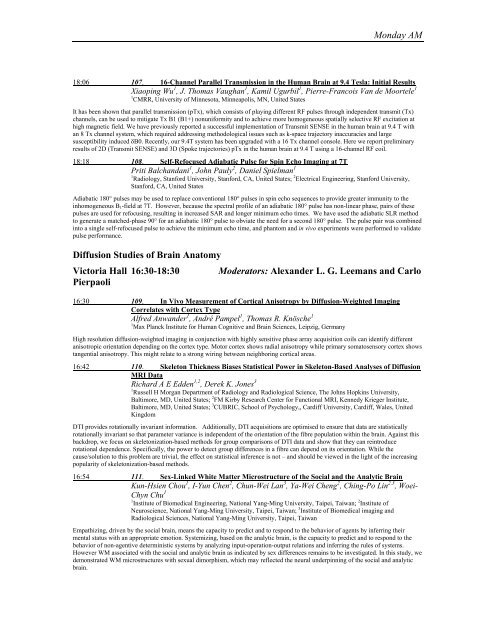OPENING SESSION - ismrm
OPENING SESSION - ismrm
OPENING SESSION - ismrm
You also want an ePaper? Increase the reach of your titles
YUMPU automatically turns print PDFs into web optimized ePapers that Google loves.
Monday AM<br />
18:06 107. 16-Channel Parallel Transmission in the Human Brain at 9.4 Tesla: Initial Results<br />
Xiaoping Wu 1 , J. Thomas Vaughan 1 , Kamil Ugurbil 1 , Pierre-Francois Van de Moortele 1<br />
1 CMRR, University of Minnesota, Minneapolis, MN, United States<br />
It has been shown that parallel transmission (pTx), which consists of playing different RF pulses through independent transmit (Tx)<br />
channels, can be used to mitigate Tx B1 (B1+) nonuniformity and to achieve more homogeneous spatially selective RF excitation at<br />
high magnetic field. We have previously reported a successful implementation of Transmit SENSE in the human brain at 9.4 T with<br />
an 8 Tx channel system, which required addressing methodological issues such as k-space trajectory inaccuracies and large<br />
susceptibility induced δB0. Recently, our 9.4T system has been upgraded with a 16 Tx channel console. Here we report preliminary<br />
results of 2D (Transmit SENSE) and 3D (Spoke trajectories) pTx in the human brain at 9.4 T using a 16-channel RF coil.<br />
18:18 108. Self-Refocused Adiabatic Pulse for Spin Echo Imaging at 7T<br />
Priti Balchandani 1 , John Pauly 2 , Daniel Spielman 1<br />
1 Radiology, Stanford University, Stanford, CA, United States; 2 Electrical Engineering, Stanford University,<br />
Stanford, CA, United States<br />
Adiabatic 180° pulses may be used to replace conventional 180° pulses in spin echo sequences to provide greater immunity to the<br />
inhomogeneous B 1 -field at 7T. However, because the spectral profile of an adiabatic 180° pulse has non-linear phase, pairs of these<br />
pulses are used for refocusing, resulting in increased SAR and longer minimum echo times. We have used the adiabatic SLR method<br />
to generate a matched-phase 90° for an adiabatic 180° pulse to obviate the need for a second 180° pulse. The pulse pair was combined<br />
into a single self-refocused pulse to achieve the minimum echo time, and phantom and in vivo experiments were performed to validate<br />
pulse performance.<br />
Diffusion Studies of Brain Anatomy<br />
Victoria Hall 16:30-18:30 Moderators: Alexander L. G. Leemans and Carlo<br />
Pierpaoli<br />
16:30 109. In Vivo Measurement of Cortical Anisotropy by Diffusion-Weighted Imaging<br />
Correlates with Cortex Type<br />
Alfred Anwander 1 , André Pampel 1 , Thomas R. Knösche 1<br />
1 Max Planck Institute for Human Cognitive and Brain Sciences, Leipzig, Germany<br />
High resolution diffusion-weighted imaging in conjunction with highly sensitive phase array acquisition coils can identify different<br />
anisotropic orientation depending on the cortex type. Motor cortex shows radial anisotropy while primary somatosensory cortex shows<br />
tangential anisotropy. This might relate to a strong wiring between neighboring cortical areas.<br />
16:42 110. Skeleton Thickness Biases Statistical Power in Skeleton-Based Analyses of Diffusion<br />
MRI Data<br />
Richard A E Edden 1,2 , Derek K. Jones 3<br />
1 Russell H Morgan Department of Radiology and Radiological Science, The Johns Hopkins University,<br />
Baltimore, MD, United States; 2 FM Kirby Research Center for Functional MRI, Kennedy Krieger Institute,<br />
Baltimore, MD, United States; 3 CUBRIC, School of Psychology,, Cardiff University, Cardiff, Wales, United<br />
Kingdom<br />
DTI provides rotationally invariant information. Additionally, DTI acquisitions are optimised to ensure that data are statistically<br />
rotationally invariant so that parameter variance is independent of the orientation of the fibre population within the brain. Against this<br />
backdrop, we focus on skeletonization-based methods for group comparisons of DTI data and show that they can reintroduce<br />
rotational dependence. Specifically, the power to detect group differences in a fibre can depend on its orientation. While the<br />
cause/solution to this problem are trivial, the effect on statistical inference is not – and should be viewed in the light of the increasing<br />
popularity of skeletonization-based methods.<br />
16:54 111. Sex-Linked White Matter Microstructure of the Social and the Analytic Brain<br />
Kun-Hsien Chou 1 , I-Yun Chen 2 , Chun-Wei Lan 3 , Ya-Wei Cheng 2 , Ching-Po Lin 2,3 , Woei-<br />
Chyn Chu 1<br />
1 Institute of Biomedical Engineering, National Yang-Ming University, Taipei, Taiwan; 2 Institute of<br />
Neuroscience, National Yang-Ming University, Taipei, Taiwan; 3 Institute of Biomedical imaging and<br />
Radiological Sciences, National Yang-Ming University, Taipei, Taiwan<br />
Empathizing, driven by the social brain, means the capacity to predict and to respond to the behavior of agents by inferring their<br />
mental status with an appropriate emotion. Systemizing, based on the analytic brain, is the capacity to predict and to respond to the<br />
behavior of non-agentive deterministic systems by analyzing input-operation-output relations and inferring the rules of systems.<br />
However WM associated with the social and analytic brain as indicated by sex differences remains to be investigated. In this study, we<br />
demonstrated WM microstructures with sexual dimorphism, which may reflected the neural underpinning of the social and analytic<br />
brain.















